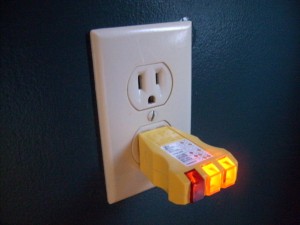
Print a Sign-In Sheet | Spanish Version
A ground fault occurs when there is a break in the low-resistance grounding path from a tool or electrical system. The electrical current may then take an alternative path to the ground through the user, resulting in serious injuries or death. The ground fault circuit interrupter, or GFCI, is a fast-acting circuit breaker designed to shut off electric power in the event of a ground fault within as little as 1/40 of a second. It works by comparing the amount of current going to and returning from equipment along the circuit conductors. When the amount going differs from the amount returning by approximately 5 milliamperes, the GFCI interrupts the current.
The GFCI is rated to trip quickly enough to prevent an electrical incident. If it is properly installed and maintained, this will happen as soon as the faulty tool is plugged in. If the grounding conductor is not intact or of low-impedance, the GFCI may not trip until a person provides a path. In this case, the person will receive a shock, but the GFCI should trip so quickly that the shock will not be harmful.
The GFCI will not protect you from line contact hazards (i.e. a person holding two “hot” wires, a hot and a neutral wire in each hand, or contacting an overhead power line). However, it protects against the most common form of electrical shock hazard, the ground fault. It also protects against fires, overheating, and destruction of wire insulation.
Source: OSHA
KEMI does not assume liability for the content of information contained herein. Safety and health remain your responsibility. This information is to be used for informational purposes only and not intended to be exhaustive or a substitute for proper training, supervision or manufacturers’ instructions/recommendations. KEMI, by publication of this information, does not assume liability for damage or injury arising from reliance upon it. Compliance with this information is not a guarantee or warranty that you will be in conformity with any laws or regulations nor does it ensure the absolute safety of any person, place or object, including, but not limited to, you, your occupation, employees, customers or place of business.

